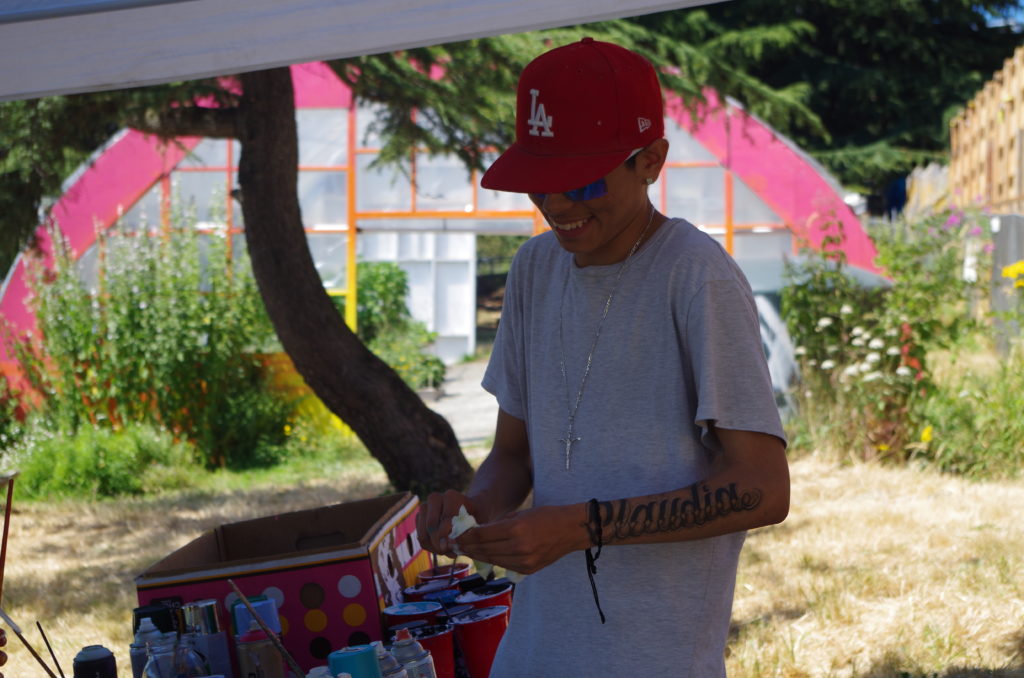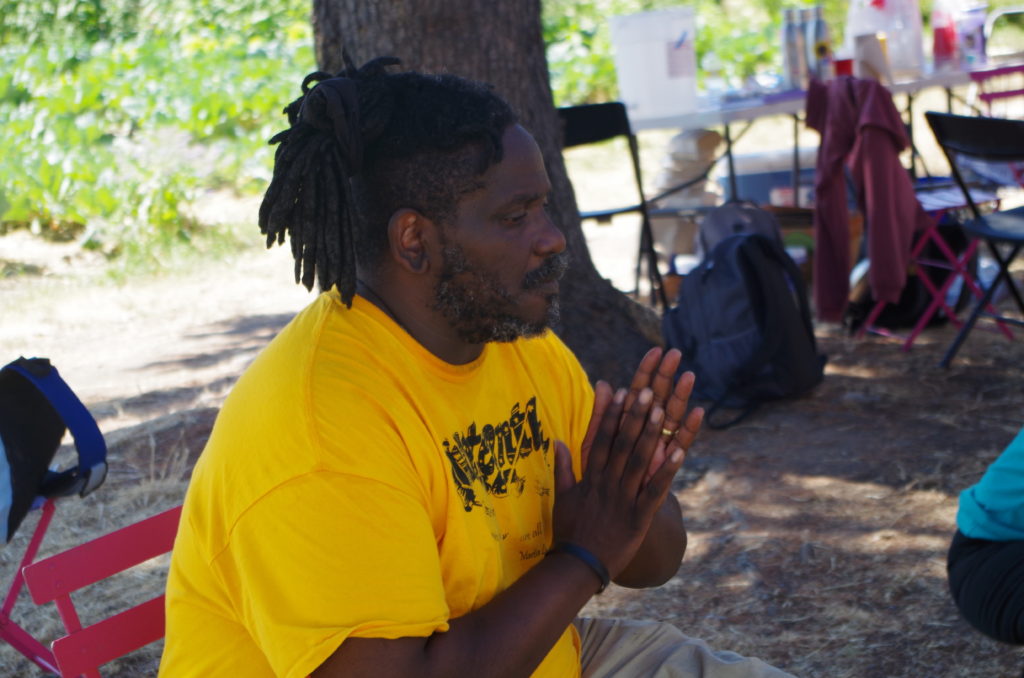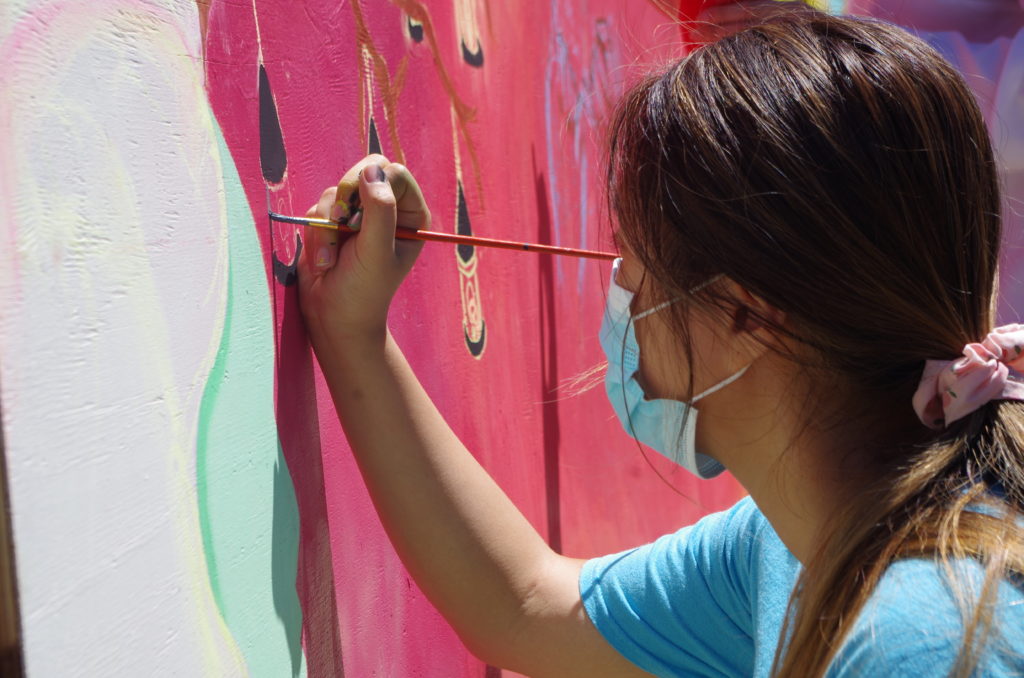
Arts Corps stepped into our future in 2022 when we launched our revamped teen arts program, Art 4 Life. This program offers youth 13-18 years old paid creative internship opportunities. This summer, Art 4 Life Digital: Art on the Web, was held virtually on Zoom and Art 4 Life Analog: Sustaining Expression, was hosted by Yes Farm, a Black Farmers Collective in Seattle. Teaching artist Meredith Arena got a chance to observe both cohorts:
When I visit the Art 4 Life Analog at Yes Farm, youth participants are scattered around the bountiful garden sketching. They circle up under the biggest tree to reflect on the activity and then buzz around, eager to see one another’s drawings before moving into the greenhouse to continue designs on some garden boxes. Art 4 Life curriculum was designed to replicate working on commission, so Yes Farm tasked them with creating a mural and designing garden boxes as a part of their learning process. The boxes are low to the ground, so most sit or lie down to paint. They collaborate, studying their sketches and planning how to bring them to life.
Hassiel, a youth who wears sunglasses and headphones, paints a strawberry with sunglasses and headphones while his fellow group members paint green vines all the way around the box. Another group paints PRIDE radishes, each radish the colors of a different pride flag. They create endless new color blends –– oranges, purples, a snappy mint green, bubblegum, and fuchsia to name a few. I watch another group split their paint roller into two tones of blue and apply a sky to their box. When the blue dries, they fill the space with sunflowers and butterflies.

Youth creativity is thriving here, saturated in the greens and yellows of the garden, dappled with long awaited sunlight. They break for a hot organic meal, which includes food from the garden made by Chef Steph, a local chef who regularly cooks for the farm. In 2021, teen programming at Arts Corps was at a crossroads. The organization needed to choose between revamping the offerings for teens or turning fully to K-8 programming. Co-Director of Arts Education, Olisa Enrico, describes the process of creating Art 4 Life, named after teaching artist Greg Thornton’s Print 4 Life, a longtime Arts Corps program. “When we stepped back to reassess, we still wanted to work with teens.” Teens are crucial to what Olisa calls the “spectrum of youth development” and she wanted to design a program that was relevant to teen lives and desires.
Olisa and other staff combed through years of student surveys, held focus groups with past and current students, and spoke with younger teaching artists who had participated as youth in Arts Corps’ previous teen programs. What would they create if they had to reinvent teen programs? The idea that emerged is now central to the Art 4 Life ethos: “You can utilize your passion for art, for success in your life. You can use your creativity toward an outcome.” They defined four main areas “like the branches of a tree,” Olisa explains. “Connecting to community, career connected learning, social justice awareness, and creative practice.”
The youth at the farm tell me they joined this program to gain and practice art skills and to get to know other young people. They seem completely relaxed at Yes Farm, moving about with their paintbrushes and sketchbooks in hand, serving themselves cold hibiscus iced tea. I watch them experiment, share ideas, ask questions, and work attentively on the task at hand. Their teaching artists Greg and Vega, along with classroom assistant ZAG, are available with suggestions and support.

Today is the fourth day of a 2-week camp and I can feel the care and commitment that teaching artists and Yes Farm have crafted for youth. Everyone belongs here in a magic that feels distinct from our everyday lives in Seattle. At the western edge of the farm, amaranth plants sway over a busy I-5, cranes and construction frame the eastern edge of the farm, where a condominium is literally being built around the young people as they Make Art Anyway.
Later, when I visit Art 4 Life Digital camp, teaching artist Sorel shares work made by Gran Fury, the propaganda artist collective of the AIDS activist organization ACT UP. Youth discuss the importance of that design work within the context of activism and the AIDS movement. They look at current activist posters too, analyzing the use of color and the effectiveness of design choices. Today is a heat wave, but all students are present at their computers for camp.
Students in Art 4 Life Digital are learning Procreate, Adobe Fresco, and Vectornator. These three apps enable Continued on next page them to design and draw digitally. They are working on Arts Corps-provided iPads with stylus pens. “I draw to show myself. I draw to heal myself,” writes student Ekram in an artist statement. Another youth, Sally, writes: “The world we live in is big and beautiful and should be shared with everyone.”
The posters students design that day showcase Arts 4 Life’s knack for teaching the totality of social justice awareness, from identity outward to environmental and political issues. They read: “Mental Health Matters,” “Proud to Be a Pacific Islander,” “Don’t Hide Your Identity,” “Wear Your Culture with Pride,” and “Beautiful World: Getting Crowded.”

Art 4 Life initially had its test run during Spring Break 2022, when four cohorts (two middle school and two high school) participated in week-long online intensives in digital art. The idea was to integrate career connected learning, which can translate to school credit, résumé building, networking, professional panels, entrepreneurship, financial workshops, and an opportunity to earn money from making artwork. Students sold their artwork through Red Bubble on stickers, tote bags and other marketable items. Similarly, Art 4 Life Analog participants this past summer designed for a specific client, learning how to actualize a vision from a sketch to painting murals.
In the chat, students tell me that they love the daily prompts, the wellness check-ins, and the opportunity to try new things and be creative every day, demonstrating how both the skills and lifestyle required to build an arts practice is woven into the Art 4 Life experience.
I speak with Hayden, a senior at Decatur High School, and Tyon, a junior at Kentwood High School, who took both the spring and summer Art 4 Life. Hayden tells me, “I joined Arts Corps for the spring and summer internships because I like learning new things about art and the process of being an artist.” Tyon adds, “Summer is 10 times better because there is more time.” He likes that the class is doing something new every day and learning more skills. Before Art 4 Life, Tyon didn’t know anything about Procreate, a digital illustration app, but now sings its praises. He jokes that Vectornator, a complex professional graphic design software, made him cry, but that he still appreciates learning it.
When asked what they would take away, Tyon says he is leaving with a better idea of how to maintain a daily creative routine and discipline with art making. It brought structure to his days this past summer. “If I weren’t doing this, I wouldn’t be doing anything,” he says.

Accessibility, availability, and relevance are cornerstones of Art 4 Life. The programs are free and the online option means that youth who don’t have access to transportation or live far from where Arts Corps programming normally takes place in South King County can participate. The need is clearly there. Arts Corps received 560 applications for a mere 60 spots last spring.
Arts Corps Program Manager Cecelia DeLeon says that the success of the program is attributed to its relevance to youth needs: a hearty stipend for participation and “loving, caring” teaching artists who “are aware and know how to ask questions” of the youth. You will not find another program like Art 4 Life in the region right now and Cecelia imagines how popular the program would be if it were available statewide.
Bold imagination –– something the entire team at Arts Corps has engaged with this year. Utilizing our collective experiences in youth development and arts education, we are responding to the ever-changinvg realities of the youth we serve. It is this imagining, listening, and care that will continue to nurture the development of Art 4 Life and all our programs.
We are now challenged to think creatively, just like our young people. The murals students created for Yes Farm depict landscapes with music notes, fiery sunsets, linked hands, and flowers. They are abundant, fertile, life affirming, and they implore us to imagine a future that is big and beautiful.
This article originally appeared in the Arts Corps 2022 Annual Report.
